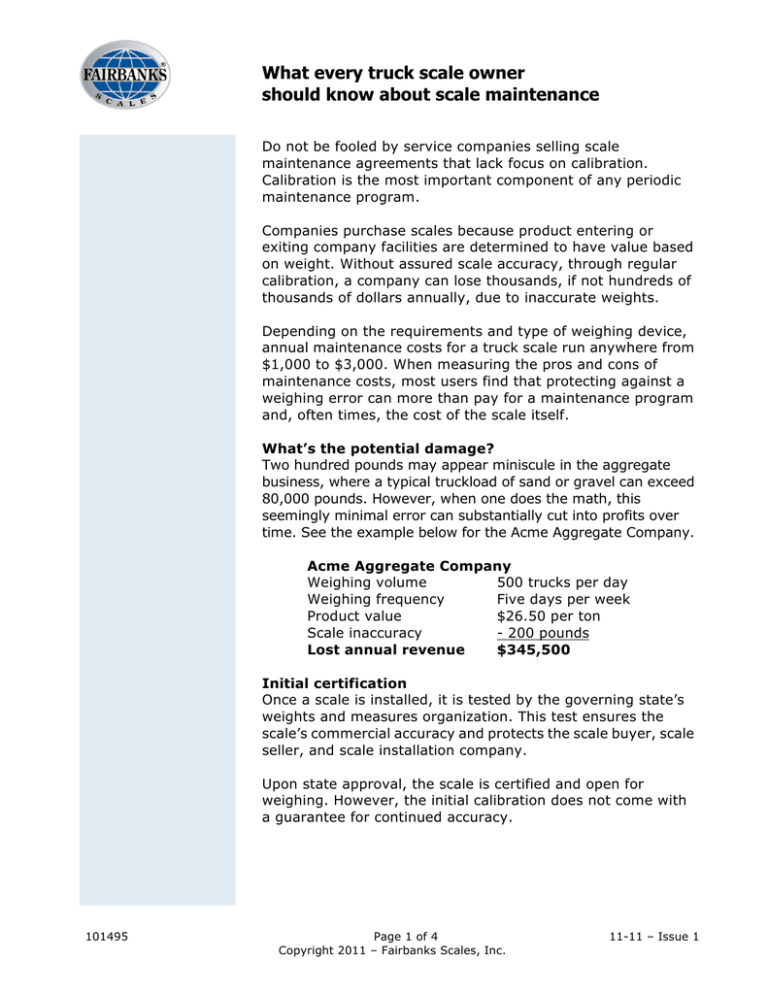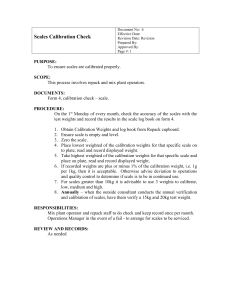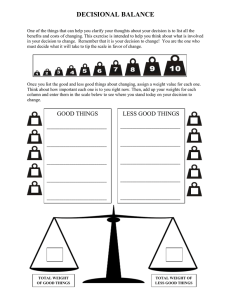What every truck scale owner should know about
advertisement

What every truck scale owner should know about scale maintenance Do not be fooled by service companies selling scale maintenance agreements that lack focus on calibration. Calibration is the most important component of any periodic maintenance program. Companies purchase scales because product entering or exiting company facilities are determined to have value based on weight. Without assured scale accuracy, through regular calibration, a company can lose thousands, if not hundreds of thousands of dollars annually, due to inaccurate weights. Depending on the requirements and type of weighing device, annual maintenance costs for a truck scale run anywhere from $1,000 to $3,000. When measuring the pros and cons of maintenance costs, most users find that protecting against a weighing error can more than pay for a maintenance program and, often times, the cost of the scale itself. What’s the potential damage? Two hundred pounds may appear miniscule in the aggregate business, where a typical truckload of sand or gravel can exceed 80,000 pounds. However, when one does the math, this seemingly minimal error can substantially cut into profits over time. See the example below for the Acme Aggregate Company. Acme Aggregate Company Weighing volume 500 trucks per day Weighing frequency Five days per week Product value $26.50 per ton Scale inaccuracy - 200 pounds Lost annual revenue $345,500 Initial certification Once a scale is installed, it is tested by the governing state’s weights and measures organization. This test ensures the scale’s commercial accuracy and protects the scale buyer, scale seller, and scale installation company. Upon state approval, the scale is certified and open for weighing. However, the initial calibration does not come with a guarantee for continued accuracy. 101495 Page 1 of 4 Copyright 2011 – Fairbanks Scales, Inc. 11-11 – Issue 1 What every truck scale owner should know about scale maintenance Why is periodic calibration necessary? Calibration is never guaranteed because accuracy is highly dependent on the way a scale is cared for and used. Weather, use and electrical current are just a few of the factors that can change the accuracy of a weighing device. Therefore, all scales need to be tested periodically. Test frequency depends on various factors: Test cart • Number of days the scale is used annually • Acceptable error rate components of a good scale maintenance program State licensed service provider State certified test weights Thorough testing process Free inspection services Reporting State licensed service providers It is important for owners to understand that a commercial scale company cannot certify a scale. The only entities that can issue certification are state weights and measures organizations. However, a commercial scale company does have the authority to recalibrate and reinstate an inaccurate scale that has been “tagged-out*” by the state, as long as the company is state licensed and registered in good standing. Owners should always request to see the valid license. *Tagged-out – When a scale fails a state weights and measures test for accuracy, the state attaches a lockout tag to the scale, rendering it unusable for commercial trade. 101495 • Price of the product being weighed Five • • • • • Test weights • Number of weighments per day State certified test weights Calibration is completed using state certified test weights. An established scale service company typically has its entire inventory of test weights tested and certified annually, in accordance with state weights and measures standards. Other service companies, however, may have only a portion of their overall weight inventory tested each year. The reason for this lack of certification is typically cost. Weight testing requires an enormous amount of time and money to prepare the weights and deliver them to a metrology laboratory for testing. Often, Page 2 of 4 Copyright 2011 – Fairbanks Scales, Inc. 11-11 – Issue 1 What every truck scale owner should know about scale maintenance weights are condemned and un-certifiable. This is why it is important to verify with your service provider that the weights have been certified. All test weights have a stamp provided by the governing state weights and measures entity. It is also common practice, among companies that value quality, to request a copy of the test weight certification from the scale service provider. Weight serial numbers will be present on the certifications, and the customer can verify these numbers against the serial numbers on the test weights used by the service company. Thorough testing process To test a weighing device properly, one must first determine the length of the platform and the total number of sections along that length. It is critical that the accuracy of load points is maintained, so as weight is applied it is transferred evenly. A scale section is determined by the presence of a load point, which is simply the location of a load sensor (also known as a load cell or strain gauge). Load points are where weight is transferred from the load to the scale and where scale accuracy is maintained. It is of critical importance, and mandated by the testing procedure of National Institute of Standards and Technology’s (NIST) Handbook 44, that the accuracy of load points are maintained, so as weight is applied, it is transferred evenly. If a load point or section fails a strain test, then it must be calibrated to conform to requirements by making a mechanical or electronic adjustment. The load point is not calibrated to a certified weight, but rather calibrated to assure all sections weigh exactly the same or within government specifications outlined in Handbook 44 and/or issued by a state sanctioned weights and measures organization. Value added service Vehicle owners cannot avoid vehicle maintenance. The same is true for scale owners. While calibration is the critical component of a scale maintenance program, a good service company will also conduct a free visual inspection and have the ability to provide any minor repairs while on site for the maintenance visit. 101495 Page 3 of 4 Copyright 2011 – Fairbanks Scales, Inc. 11-11 – Issue 1 What every truck scale owner should know about scale maintenance A visual inspection should include: • Condition of scale • Regulatory conformance issues Visual inspection • Any damages • Safety • Clearance • Grounding • Mud/debris build-up • Use issues • Corrosion • Electrical conditions A reputable service company will look at these items, as well as others, and offer solutions to any issues that are discovered Most scale owners understand that it is better to repair and address issues when they are small, rather than wait until they are big and expensive. Reporting A good scale maintenance program will provide thorough reporting for its client. Each maintenance inspection should include a written report that documents test results, both before and after calibration, as well as a summary of finding and recommendations, based on a free visual inspection. About Fairbanks In 1830, Fairbanks Scales was founded in St. Johnsbury, Vermont, by Thaddeus Fairbanks, inventor of the world’s first platform scale. Fairbanks manufactures technology-based scale products, provides nationwide service solutions and is a proud “Made in the U.S.A.” company with more than 300 field service personnel. Fairbanks Scales, Inc. Corporate Headquarters 821 Locust, Kansas City, Missouri 64106 United States of America Tele: (800) 332-1123 www.fairbanks.com. 101495 Page 4 of 4 Copyright 2011 – Fairbanks Scales, Inc. 11-11 – Issue 1


